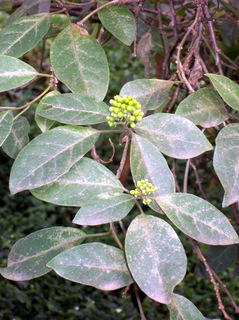Downy chance facts for kids
Quick facts for kids Downy chance |
|
|---|---|
 |
|
| Downy chance - Denistone, New South Wales | |
| Scientific classification | |
| Genus: |
Clerodendrum
|
| Species: |
tomentosum
|
The Clerodendrum tomentosum, often called the downy chance, is a special plant. You might also hear it called the hairy lolly bush or hairy clairy. This plant grows as a shrub or a small tree. You can find it in eastern and northern Australia. It grows from Batemans Bay in southern New South Wales all the way up to Queensland, the Northern Territory, and Western Australia. It also grows in New Guinea.
This plant likes to live at the edges of warm rainforests. It can even survive in places that get less than 1000 millimeters of rain each year.
Contents
What's in a Name?
The name "downy chance" is quite interesting! It comes from the plant's scientific names. The first part, Clerodendrum, was named by Carl Linnaeus. He is known as the "father of modern taxonomy." "Clerodendrum" comes from Greek words. It means "allotment tree." The second part, "tomentosum," means "downy" or "hairy." This describes the plant's leaves.
Scientists used to think the Downy chance belonged to the verbena family. But new studies show it is actually part of the mint family. So, it moved from the Verbenaceae family to the Lamiaceae family.
How to Spot a Downy Chance
The Downy chance can grow up to 15 meters tall. Its trunk can be about 25 centimeters wide. But usually, it is much smaller. It is a plant with many branches. It has large leaves with clear veins.
The trunk is usually round. Sometimes it has wider parts at the bottom. The bark is grey or light brown. On older plants, it can look scaly or corky. Young branches have small dots called lenticels. They are soft and downy. These branches are often angled or square. They are brownish-grey and sometimes purple at the tips.
Look at the Leaves!
The leaves grow opposite each other on the stem. They do not have jagged edges. They are usually 4 to 14 centimeters long. They are about 2 to 4.5 centimeters wide. Each leaf has a short tip. The leaf shape gets narrower towards the base. The top of the leaf can be a bit hairy. The underside is very hairy. It feels soft and downy when you touch it. The underside is pale green. The top is a darker green.
The leaf veins are easy to see on the underside. You can also see them on the top. There are usually 5 or 6 main veins. They curve near the edge of the leaf.
Flowers and Fruity Fun
White flowers grow in thick clusters. You can see them from October to January. They form in special groups called cymes. These groups then form larger, flat-topped clusters called corymbs. The flowers smell nice. They have four long parts called stamens that stick out.
The fruit is a shiny black or navy blue drupe. It has four sections. A bright red, fleshy cup called a calyx surrounds the fruit. The red and black colors of the fruit attract birds. Birds like the satin bowerbird love to eat them. The fruit is small, about 5 to 8 millimeters wide. The red calyx can be up to 20 millimeters wide.
Nocturnal moths help pollinate the flowers. This means moths that fly at night help the plant make seeds. The fruit is not safe for humans to eat. It takes a long time for new plants to grow from seeds. But you can grow them from cuttings.
Why is it Important?
The Downy chance has beautiful flowers and fruit. This makes it a great plant for native gardens in Australia. It helps attract birds and butterflies to your garden. It is also a "pioneer species." This means it is one of the first plants to grow in areas that are being restored.
See also
 In Spanish: Chance velloso para niños
In Spanish: Chance velloso para niños

